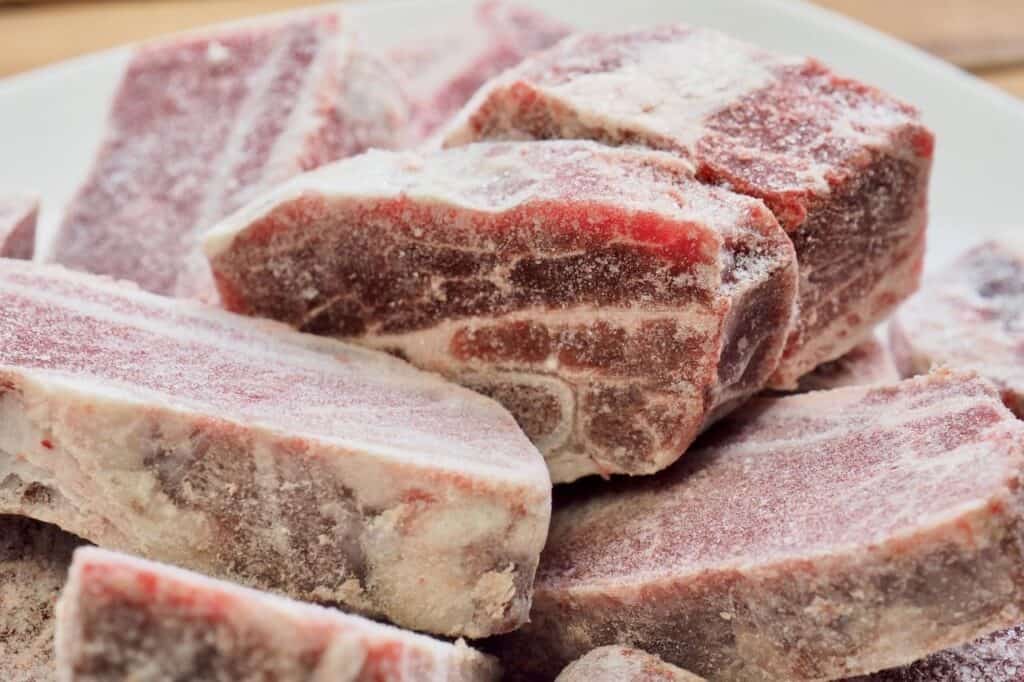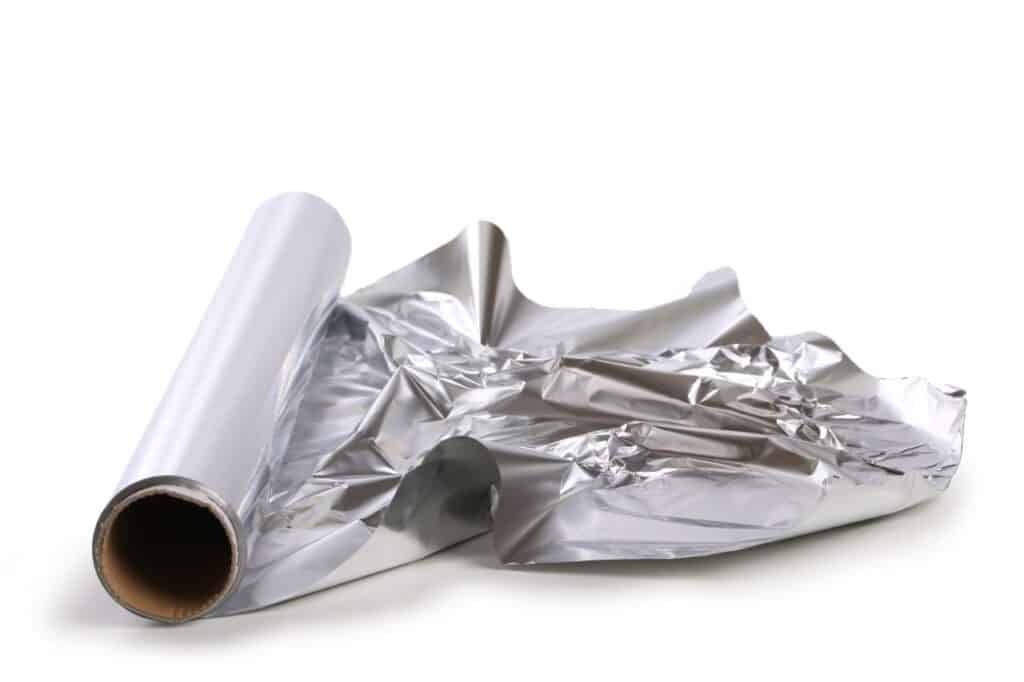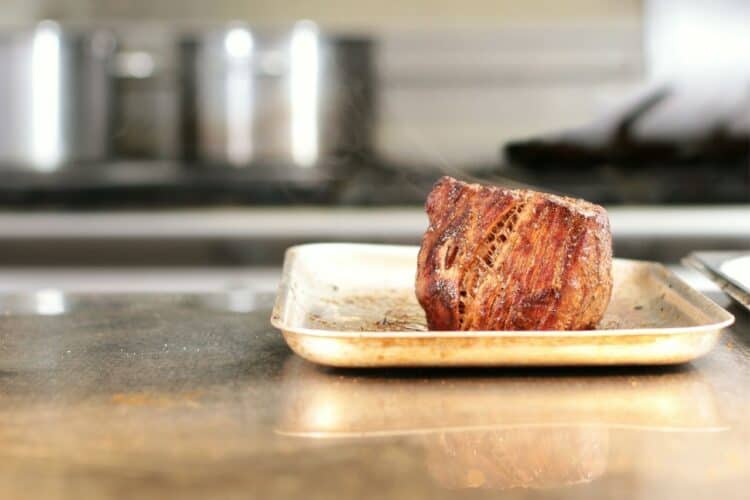It is always tempting to dig right into a perfectly cooked steak. However, as the old saying goes, “all the good things are worth waiting for”, the same is true when it comes to steaks. Letting the steak rest for a bit before slicing a big chunk can make a big difference.
5 to 7 minutes is the minimum resting time for steak when short for time. However, for thicker cuts of steak, 10 to 20 minutes is recommended before slicing it. The ideal internal temperature of steak should be around 120-130°F (49°C – 54°C), and an external temperature of around 125-140°F (51°C – 60°C). However, most chefs prefer the timing method rather than using a probe thermometer as it can leak out the juices when the steak is punctured.
Whichever method you prefer, the important thing is resting the steak first before serving.
Why Letting The Steak Rest First Is Important
Allowing the steak or any meat to rest is essential to prevent it from getting dry. Doing this can help reabsorb and redistribute the juices evenly in the meat. Have you ever tried slicing a steak right after you take it out of the grill? If so, I’m sure you’ve noticed the internal juices running out from the meat. As a result, you probably have a tough and dry steak.
The reason for this is because the cells of the meat constrict in the cooking process. When this happens, the juices are pushed into the centre of the meat due to its cooler temperature.
However, the meat’s constriction is only temporary. By giving the meat a few minutes to rest and cool down a bit, the cells will go back to their original shape. This will allow the juices to be redistributed within the meat.
The redistribution of the juices will only happen if you cook the steak right. If you overcook it, most of the juices have already evaporated and the cells will not go back to their original form, thus leaving you with a chewy, flavourless, and dry steak. When you let the steak rest, you will end up with a slice of juicy and flavourful meat.
Now, some may argue that letting the meat rest may reach hazardous food temperatures. That’s a valid concern but there is nothing to worry about. Because even after the meat is taken out of the heat, it continues to cook a bit which is still at a safe temperature even after letting it rest.
How To Properly Rest A Steak

While most people may rest their steaks in several different ways, this method is the one I use and what many people practice as well. You only need a cutting board or a warm serving platter and a piece of aluminium foil.
Once you have removed the steak from the grill or heat, place it on the cutting board or warm plate. Using the foil, form a tent above the steak.
Make sure to place the tent of foil loosely. This will help keep some heat on the meat. Remove the aluminium foil after the applicable resting time and then finally, cut and serve.
As mentioned above, the steak should rest for at least 5 to 7 minutes at a minimum; longer if the steak is thicker. Using a probe thermometer may no longer be an option since it may compromise the juiciness and flavour of the steak.
So, if you are not pressed for time and has a big chunk of steak, how would you know the appropriate resting time before you take off your foil?
When unsure of the applicable rest time, you can use the guideline below.
- 1 minute for every hundred grams
- 5 minutes for every one inch thick
- 10 minutes for every pound
If the meat is too thick, you can rest it for the same time it took you to cook it or half of its time if it’s not too thick.
How To Keep Meat Juicy
Aside from letting the meat rest before cutting up and serving, there are still other ways to help you get a juicy steak. To avoid tough, flavourless, and dry steak, here are a few tips to keep in mind.
Never Overcook Your Meat
Overcooking your meat can be as dangerous as undercooking it. Many tend to overcook their meat for fear of eating raw or undercooked food. While it’s true that it’s unhealthy to eat raw meat, overcooking it does not mean it’s healthier.
Besides, cooking dry flesh over very high temperatures can also produce chemical compounds that are dangerous. Anyway, overcooking your steak can make them dry since the juices have evaporated already.
Brine It
Another way to keep the meat juicy is by brining it before cooking. You can lose meat moisture in the process of cooking and brining can help minimize the amount of lost moisture. Only 15% of the moisture is lost with brined meat while it’s 30% is for unbrined meat.
If you are not familiar with brining, it is done by mixing 1 gallon of water with 1 cup of salt. Place the meat on the brine and leave it there for at least 4 hours before rinsing thoroughly. Don’t worry about making your meat salty. Brining does not add saltiness to the meat.
Keep The Meat Moist
Keeping your meat moist before cooking can help keep it juicy afterwards. You can do this by using a marinade to keep them moist or by carefully cooking them for a short time over high heat. Just be careful when using marinades with sugar as it can burn easily.
Mistakes To Avoid When Cooking Steaks
Letting the steak rest before serving is just a small part when it comes to a perfectly cooked steak. Even if you let it rest before cutting, you may still not get the result you’re expecting. For your sake, I have listed down the common mistakes people make when cooking steak.
1. Cooking It Straight From The Fridge

When cooking steak, patience is one trait you need to practice. Never cook a steak cold. Give it some time to sit at room temperature for at least 30 minutes to 1 hour before throwing it on the grill. Putting it on the grill cold will result in uneven cooking.
2. Under Seasoning Or Not Seasoning At All
Okay, I get it. You don’t want to end up with a very salty slab of meat. However, when it comes to steak, remember that it’s only the outside that’s seasoned. So, don’t be afraid to apply a generous amount of seasoning on both sides of the meat before cooking. When to apply the seasoning? Well, it all depends on you but to be safe, season it at least 30 minutes before cooking.
3. Using The Wrong Type Of Oil
Many would prefer to use extra virgin olive oil due to its flavour and health benefits. However, when it comes to cooking in very high heat, EVOO is not the best option due to its low smoke point.
Instead, use canola or peanut oil for your steak, since they have higher smoke points. Remember that steaks are best cooked at high temperature and choosing an oil with a low smoke point may release toxic chemicals.
4. Choosing The Wrong Cut
Not all cuts are the same with steaks. There are several varieties and each has different optimal ways of cooking. Boneless ribeye is perfect on the pan and T-bone is best cooked on the grill.
Going for lean cuts is also a bad choice for steaks as they can get dry and tough. So, before cooking your steak, be sure to learn the different cuts and how you want to cook them. A steak with a nice amount of fat will give you a tender and juicy outcome.
5. Opting For Low-Quality Meat
Lastly is the quality of meat. High-quality steaks can be expensive, however, if you want to enjoy a nice piece of steak then don’t compromise the quality. When choosing your meat, go for one that has the brightest red colour. As much as possible, avoid meat with grey or brown areas or spots.
Related Questions

It is possible to rest a steak for too long. Covering it tightly for a long time will get it overcooked and will dry your steak out. The only problem is that letting your steak rest for too long will make it cold, and eating a cold steak is not a good idea.
You can rest a steak without getting cold by making an aluminium foil tent. The foil tent will help that steak to keep warm. Do not wrap the steak tightly in foil because it will cool and dry it out. You can also put it over a warm plate. You can warm it by microwaving your plate. You can also rest your steak without getting cold by putting it in the oven under water.
- Does Using Pellet Smokers Dry Out Meat? – Myth or Fact - January 4, 2022
- 12 Best Meats To Cook On A Pellet Smoker - December 30, 2021
- Dry Brining: What, How, Why & More - December 28, 2021


